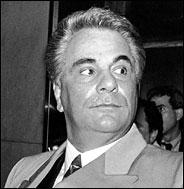
from The New York Times
Five Families: Made Men in America
Reviewed by Bryan Burrough
Earlier this year The Times published a front-page article describing an F.B.I. drive to rid the New York waterfronts of Mafia influence. At first glance the story appeared so anachronistic it was jarring. The Mafia? You mean those guys still exist? Given the fact that New York hasn't hosted a decent godfather since Sammy the Bull ratted out John Gotti 14 years ago, one might be forgiven for believing that the world of Italian-American organized crime had gone the way of other crumbling pillars of midcentury American culture, like heavyweight boxing, thoroughbred horse racing and the Democratic Party.
But no. Despite a 25-year onslaught by prosecutors armed with high-tech listening devices and racketeering statutes, despite the fact that so many mobsters have been sent away that not one of New York's infamous "five families" even has an identifiable godfather at the moment, rumors of the Mafia's death appear premature. Still, the mob's influence in the opening years of the 21st century remains a far cry from its glory days, as Selwyn Raab reminds us in his excellent history of the New York Mafia, Five Families: The Rise, Decline, and Resurgence of America's Most Powerful Mafia Empires.
For Raab, a veteran reporter who has spent decades chronicling the city's not-so-wiseguys, this book amounts to a kind of lifetime achievement award, granted for long years shouting questions at handcuffed men named Momo and Quack-Quack, studying wiretapped chats at "social clubs" like the Ravenite in Little Italy and trailing the drooling, bathrobe-clad Vincent "Chin" Gigante as he staged his long-running charade of mental incapacitation in the alleys of SoHo.
Mafia nonfiction is not a genre given to rigorous documentation and sound sourcing. What makes Raab so wonderful is that he eschews legend and suspect anecdotage in favor of a Joe Friday-style just-the-facts-ma'am approach. In a 765-page book, not one gangster is "linked" to anything more profound than a keychain. Readers raised on stories of mob ties to this president or that Hollywood chieftain will be disappointed. Frank Sinatra gets two paragraphs tops, Jack Kennedy's Mafia connections barely a clause. But just about everyone who should receive his due does, from Meyer Lansky and Joe Valachi to "Donnie Brasco" and John Gotti.
Therein lies Raab's challenge: organizing the mounds of material he has gathered over the years. This is a book that tells the story of 200 men named Vincent. Everyone else seems to be Tony. By and large, Raab makes things easy to follow with the help of a priceless naming strategy. Rather than repeatedly referring to a mobster as Anthony "Fat Tony" Salerno or simply Salerno -- there must 15 Salernos in this book -- Raab removes the quotation marks on second reference. George Herbert Walker Bush, meet Philip Benny Squint Lombardo.
Raab divides his mass of reportage into three sections: one on Mafia history to 1970; a second on the F.B.I.'s awakening and the use of new RICO laws that culminated in the so-called Commission trial of 1985; and a final section that charts the subsequent fates of each of the five families, or borgatas, as Raab properly terms them. His brisk history reminds us that the Italian-American Mafia's creation was Benito Mussolini's doing; it was Il Duce's crackdown on Sicilian Mafiosi that sent so many of them scrambling for American shores. In quick, deft strokes, Raab explains how the mob was created in 1931 -- by Charles Lucky Luciano -- as a treaty settling the street battles of two Italian outfits.
From there the boldfaced names fly by. Tom Dewey, Frank Costello, Albert Anastasia, Dutch Schultz, Abe Reles -- the gang's all here. Five Families sags a bit as Raab introduces the generation of youngish prosecutors and F.B.I. agents who finally rouse law enforcement from decades of slumber to confront the mob in the late 1970's. But he hits his stride when he reaches the gangsters he knows best, those who presided over the Mafia's decline in the 1980's and 90's. Paul Castellano, John Gotti and Sammy Gravano spring to life for the first time in years, and Raab tells their story with precision and gusto.
The book's finest moments are reserved for Gotti's lesser-known peers, scary third-rate mooks like Anthony Gaspipe Casso of the Luccheses, Carmine the Snake Persico of the Colombos and Joe the Ear Massino of the wheezing Bonannos. Their Shakespearean outer-borough downfalls, heretofore banished to inside pages of The New York Post, bring Macbeth to Maspeth. New York's mob families, it seems, could weather Rudy Guiliani and Donnie Brasco, but they were helpless against their own. When Sammy the Bull trashed omerta by cutting a deal with prosecutors, the floodgates of betrayal swung open, never to be closed. Dozens of Mafiosi squealed before heading off to ranch-house retirements in the Witness Protection Program. When a godfather, Gaspipe Casso, joined the rat parade, the Mafia's fate was sealed.
One's quibbles with Five Families lie chiefly with the inelegant writing; Raab may gather facts like Joe Friday, but he's no threat to Proust. The only thing he loves more than a bloody Mafia hit is the passive voice. And he suffers from an irritating case of explanitis, a malady in which every conceivable reference, from Little Lord Fauntleroy to Crazy Horse, is defined. (Even my 9-year-old knows what "wearing a wire" means.)
In an apparent attempt to buoy its relevance, the book's subtitle refers to the Mafia's ''resurgence.'' This is a stretch. Raab takes 688 pages detailing the New York mob's operatic rise and fall; its supposed resurgence makes up the last 20. One can easily forgive this off-key final aria, however. Five Families is the finest Mafia history we're likely to see for a good long while.
Bryan Burrough is the author of "Public Enemies: America's Greatest Crime Wave and the Birth of the FBI, 1933-34"

No comments:
Post a Comment